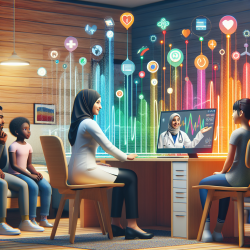Introduction
In the evolving landscape of healthcare, the integration of technology into patient care is becoming increasingly prevalent. A systematic review titled "How patient-generated health data and patient-reported outcomes affect patient–clinician relationships" sheds light on the impact of patient-generated health data (PGHD) and patient-reported outcomes (PROs) on patient-clinician relationships. This blog aims to explore how these findings can be applied to improve clinical practice, particularly for practitioners involved in speech-language pathology and online therapy services like those provided by TinyEYE.
Understanding the Impact of PGHD and PROs
The systematic review identifies three main themes regarding the impact of PGHD and PROs on patient-clinician relationships:
- Enhanced communication and health awareness between patients and clinicians.
- Challenges faced by clinicians in accommodating patient expectations regarding data review.
- The role of PGHD platform features in supporting or hindering collaboration.
These themes highlight the dual nature of PGHD and PROs as both facilitators and potential stressors in the patient-clinician dynamic.
Strategies for Practitioners
For practitioners in speech-language pathology and other fields, leveraging PGHD and PROs can lead to improved outcomes by fostering better communication and understanding. Here are some strategies based on the review findings:
- Set Clear Expectations: Establish clear communication with patients about how PGHD will be used in their care. This includes setting realistic expectations for data review and response times.
- Incorporate PGHD into Clinical Workflows: Develop workflows that integrate PGHD effectively, such as using summarized reports for quick review during patient encounters.
- Utilize Technology for Better Engagement: Choose PGHD platforms that offer user-friendly interfaces and summary features that can enhance patient-clinician collaboration.
Opportunities for Further Research
While the review provides valuable insights, it also highlights areas where further research is needed. Practitioners are encouraged to contribute to the growing body of knowledge by exploring:
- The impact of PGHD on specific clinical outcomes in speech-language pathology.
- Patient perspectives on the use of PGHD in their care plans.
- Innovative ways to overcome barriers in PGHD integration within clinical settings.
Conclusion
The integration of PGHD and PROs into clinical practice holds great promise for enhancing patient-clinician relationships. By understanding and applying the findings of this systematic review, practitioners can improve communication, tailor interventions, and ultimately achieve better health outcomes for their patients. As we continue to embrace technology in healthcare, ongoing research and adaptation will be key to realizing the full potential of PGHD and PROs.
To read the original research paper, please follow this link: How patient-generated health data and patient-reported outcomes affect patient–clinician relationships: A systematic review.










